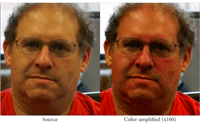Is baby still breathing? Find out… from a video!
posted Thursday, June 14, 2012 at 3:45 PM EST
 In the early 1970s, British author Arthur C. Clarke famously wrote that "any sufficiently advanced technology is indistinguishable from magic". A research paper and accompanying video mentioned on the blog of John Nack, Principal Product Manager, Mobile at Adobe Systems seems to us to fit the bill.
In the early 1970s, British author Arthur C. Clarke famously wrote that "any sufficiently advanced technology is indistinguishable from magic". A research paper and accompanying video mentioned on the blog of John Nack, Principal Product Manager, Mobile at Adobe Systems seems to us to fit the bill.
In the paper, six researchers at MIT's Computer Science and Artificial Intelligence Laboratory and Quanta Research Cambridge, Inc. together describe a method for amplifying subtle motions and near-invisible color changes in video footage. As you'd expect of a research paper, the underlying math is rather complex to say the least, but the examples in the accompanying video are instantly understandable, and frankly, jaw-droppingly cool.
The video shows before-and-after footage of a sleeping baby, and it's immediately obvious from the processed video that baby is still breathing. In the original video, while that same motion is still visible, it's much more subtle. In another clip, the team shows a clear human wrist pulse in a processed video, alongside an original video in which we're hard-put to spot any motion at all. Perhaps most impressively, a video is processed to make clear the subject's pulse over their entire face, as their skin tone cycles from dark to light with each heartbeat.
If you're the least bit interested in what can be achieved with some clever math and modern tech, the whole video is very informative, if a little dry. If you just want to focus on the real attention-grabbing clips, though, we recommend skipping ahead first to one minute, 30 seconds for the color-amplified pulse, and then to three minutes, 20 seconds for the other motion-amplified examples.
(via John Nack on Adobe; more info in the research paper 'Eulerian Video Magnification for Revealing Subtle Changes in the World')